Difference between revisions of "How to Configure Microsoft Outlook 2003"
From Spiffy Stores Knowledge Base
| (3 intermediate revisions by one other user not shown) | |||
| Line 6: | Line 6: | ||
''Note:'' In these instructions, ''yourstore'' refers to the name given to your Spiffy Store, and this is the name that appears in your spiffystores.com domain name. For example, if your store is called '''sellmore''', then your Spiffy Stores domain name will be '''sellmore.spiffystores.com'''. | ''Note:'' In these instructions, ''yourstore'' refers to the name given to your Spiffy Store, and this is the name that appears in your spiffystores.com domain name. For example, if your store is called '''sellmore''', then your Spiffy Stores domain name will be '''sellmore.spiffystores.com'''. | ||
| + | |||
| + | <div id="note-box"> | ||
| + | Please Note: We provide online tutorials to help you configure your email software as a courtesy. However, our support staff are unable to provide any support on how to use or configure third-party software on your computer, laptop, tablet or smartphone. We will provide support for any issues relating to the software and services on our servers, but you will need to contact the software manufacturer or visit their relevant online support pages for help with the software that they provide. | ||
| + | </div> | ||
'''To set up Microsoft Outlook 2003:''' | '''To set up Microsoft Outlook 2003:''' | ||
| Line 13: | Line 17: | ||
# Choose "Add a new e-mail account", and click "Next".<br><br>[[Image:Email outlook2003_2.png]]<br><br> | # Choose "Add a new e-mail account", and click "Next".<br><br>[[Image:Email outlook2003_2.png]]<br><br> | ||
# For your server type, select "POP3" and click "Next".<br><br>[[Image:Email outlook2003_3.png]]<br><br> | # For your server type, select "POP3" and click "Next".<br><br>[[Image:Email outlook2003_3.png]]<br><br> | ||
| − | # On the Internet E-mail Settings (POP3) window, enter your information as follows:<br><table><tr><td style="width: 40%;">Your Name:</td><td>Enter your first and last name</td></tr><tr><td style="vertical-align: top;">E-mail Address:</td><td>Enter your | + | # On the Internet E-mail Settings (POP3) window, enter your information as follows:<br><table><tr><td style="width: 40%;">Your Name:</td><td>Enter your first and last name.</td></tr><tr><td style="vertical-align: top;">E-mail Address:</td><td>Enter your email address. If you're also using a custom domain name in your store, you can enter the email address that you want people to see when you send them email, e.g. "joe@joeswidgets.com". If you don't have your own domain name, just use the "''yourstore''.spiffystores.com" domain name.</td></tr><tr><td style="vertical-align: top;">User Name:</td><td>Your username should be your full Spiffy Stores email address as it appears in your store toolbox on the "Preferences >> Email Accounts" page, e.g. "joe@joeswidgets.spiffystores.com".</td></tr><tr><td>Password:</td><td>Enter the password you set up for your email account.</td></tr><tr><td>Incoming mail server (POP3):</td><td>mail.spiffystores.com</td></tr><tr><td>Outgoing mail server (SMTP):</td><td>mail.spiffystores.com</td></tr></table><br><br>[[Image:Email outlook2003_4.png]]<br><br> |
# Click "More Settings...". | # Click "More Settings...". | ||
# On the Internet E-mail Settings window, select the "Outgoing Server" tab.<br><br>[[Image:Email outlook2003_5.png]]<br><br> | # On the Internet E-mail Settings window, select the "Outgoing Server" tab.<br><br>[[Image:Email outlook2003_5.png]]<br><br> | ||
# Select "My outgoing server (SMTP) requires authentication".<br><br>[[Image:Email outlook2003_6.png]]<br><br> | # Select "My outgoing server (SMTP) requires authentication".<br><br>[[Image:Email outlook2003_6.png]]<br><br> | ||
# Select "Use same settings as my incoming mail server".<br><br>[[Image:Email outlook2003_7.png]]<br><br> | # Select "Use same settings as my incoming mail server".<br><br>[[Image:Email outlook2003_7.png]]<br><br> | ||
| − | # Select the "Advanced" tab. | + | # Select the "Advanced" tab. |
| − | # Click OK | + | #* Change the "Incoming server (POP3)" port to 995 and tick the "SSL" box. |
| − | # You should now | + | #* Change the "Outgoing server (SMTP)" port to 465 and tick the "SSL" box. |
| + | #* If you would also like to use webmail to read your messages, then you need to set the options to leave the messages on the server for a number of days. | ||
| + | #* You can also choose to delete messages from the server when you delete them in Outlook.<br><br>[[Image:Email outlook2003_8.png]]<br><br> | ||
| + | # Click "OK". | ||
| + | # You should now return to the "E-mail Accounts" window, so Click "Next", and "Finish" to save your settings.<br><br>[[Image:Email outlook2003_9.png]]<br><br>[[Image:Email outlook2003_10.png]]<br><br> | ||
# You may need to review your account settings if you want to customize the way Outlook handles your email. You can find more information about Outlook at http://support.microsoft.com/ph/2520/en-au. | # You may need to review your account settings if you want to customize the way Outlook handles your email. You can find more information about Outlook at http://support.microsoft.com/ph/2520/en-au. | ||
Latest revision as of 15:01, 14 May 2014
Setting Up Microsoft Outlook 2003
To read your email messages using Microsoft Outlook 2003, you will need to configure several Microsoft Outlook email service options.
For other email software, refer to How to set up your email program to access your Spiffy Stores mailboxes
Note: In these instructions, yourstore refers to the name given to your Spiffy Store, and this is the name that appears in your spiffystores.com domain name. For example, if your store is called sellmore, then your Spiffy Stores domain name will be sellmore.spiffystores.com.
Please Note: We provide online tutorials to help you configure your email software as a courtesy. However, our support staff are unable to provide any support on how to use or configure third-party software on your computer, laptop, tablet or smartphone. We will provide support for any issues relating to the software and services on our servers, but you will need to contact the software manufacturer or visit their relevant online support pages for help with the software that they provide.
To set up Microsoft Outlook 2003:
- Open Microsoft Outlook.
- Select "Tools >> E-mail Accounts..." from the menu.
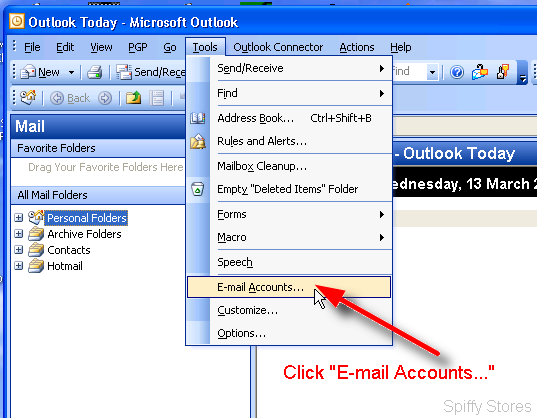
- Choose "Add a new e-mail account", and click "Next".
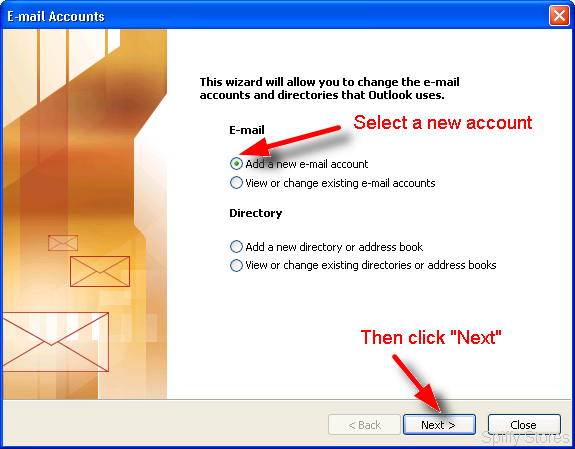
- For your server type, select "POP3" and click "Next".
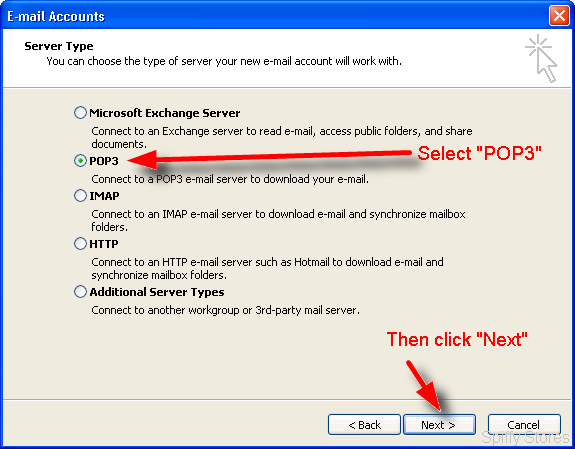
- On the Internet E-mail Settings (POP3) window, enter your information as follows:
Your Name: Enter your first and last name. E-mail Address: Enter your email address. If you're also using a custom domain name in your store, you can enter the email address that you want people to see when you send them email, e.g. "joe@joeswidgets.com". If you don't have your own domain name, just use the "yourstore.spiffystores.com" domain name. User Name: Your username should be your full Spiffy Stores email address as it appears in your store toolbox on the "Preferences >> Email Accounts" page, e.g. "joe@joeswidgets.spiffystores.com". Password: Enter the password you set up for your email account. Incoming mail server (POP3): mail.spiffystores.com Outgoing mail server (SMTP): mail.spiffystores.com 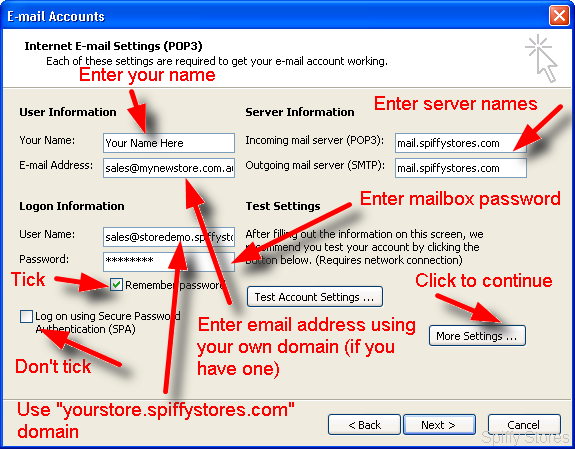
- Click "More Settings...".
- On the Internet E-mail Settings window, select the "Outgoing Server" tab.
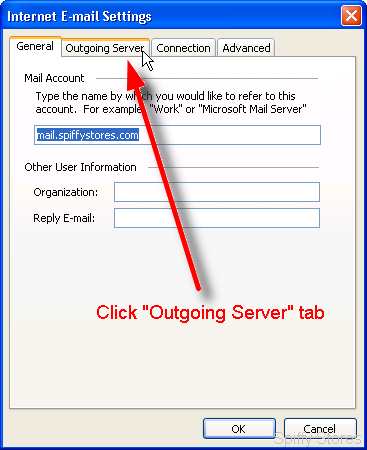
- Select "My outgoing server (SMTP) requires authentication".
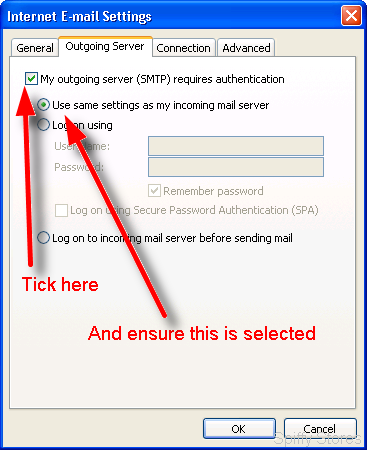
- Select "Use same settings as my incoming mail server".
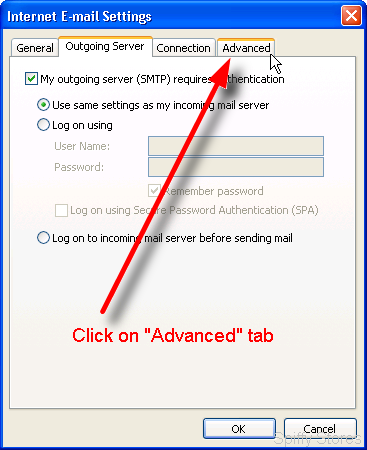
- Select the "Advanced" tab.
- Change the "Incoming server (POP3)" port to 995 and tick the "SSL" box.
- Change the "Outgoing server (SMTP)" port to 465 and tick the "SSL" box.
- If you would also like to use webmail to read your messages, then you need to set the options to leave the messages on the server for a number of days.
- You can also choose to delete messages from the server when you delete them in Outlook.
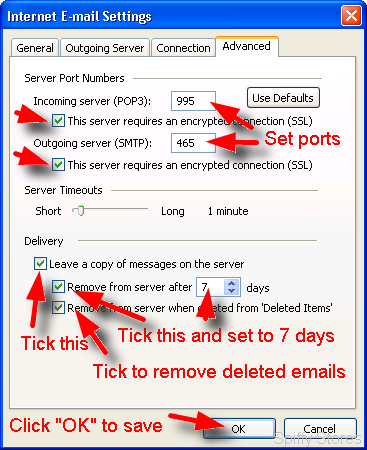
- Click "OK".
- You should now return to the "E-mail Accounts" window, so Click "Next", and "Finish" to save your settings.
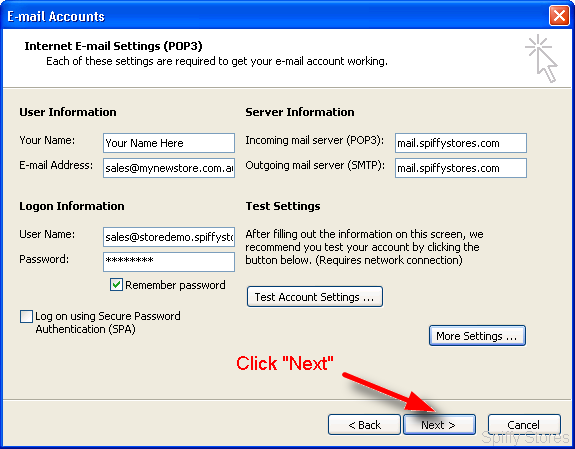
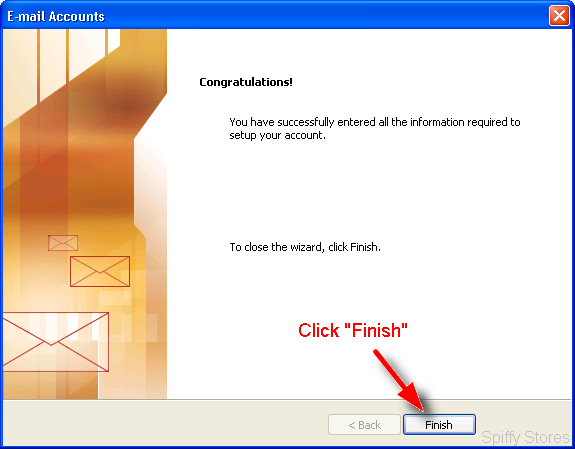
- You may need to review your account settings if you want to customize the way Outlook handles your email. You can find more information about Outlook at http://support.microsoft.com/ph/2520/en-au.